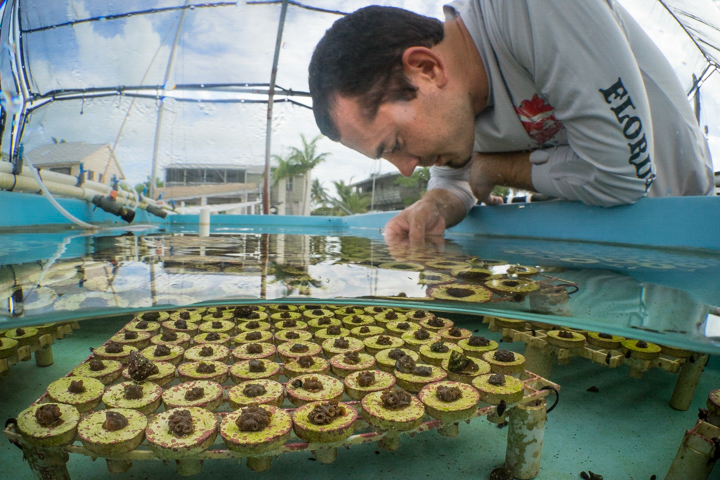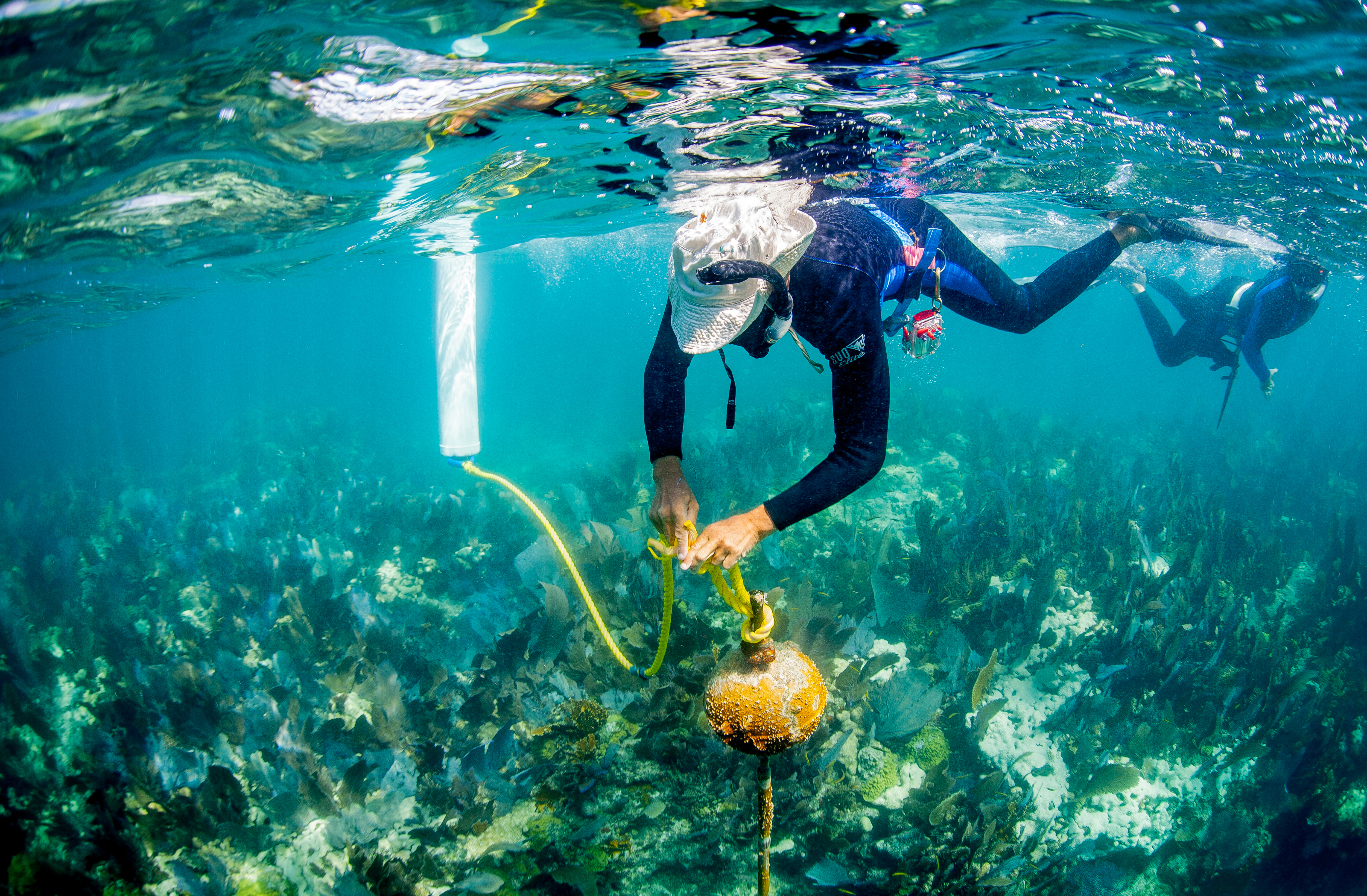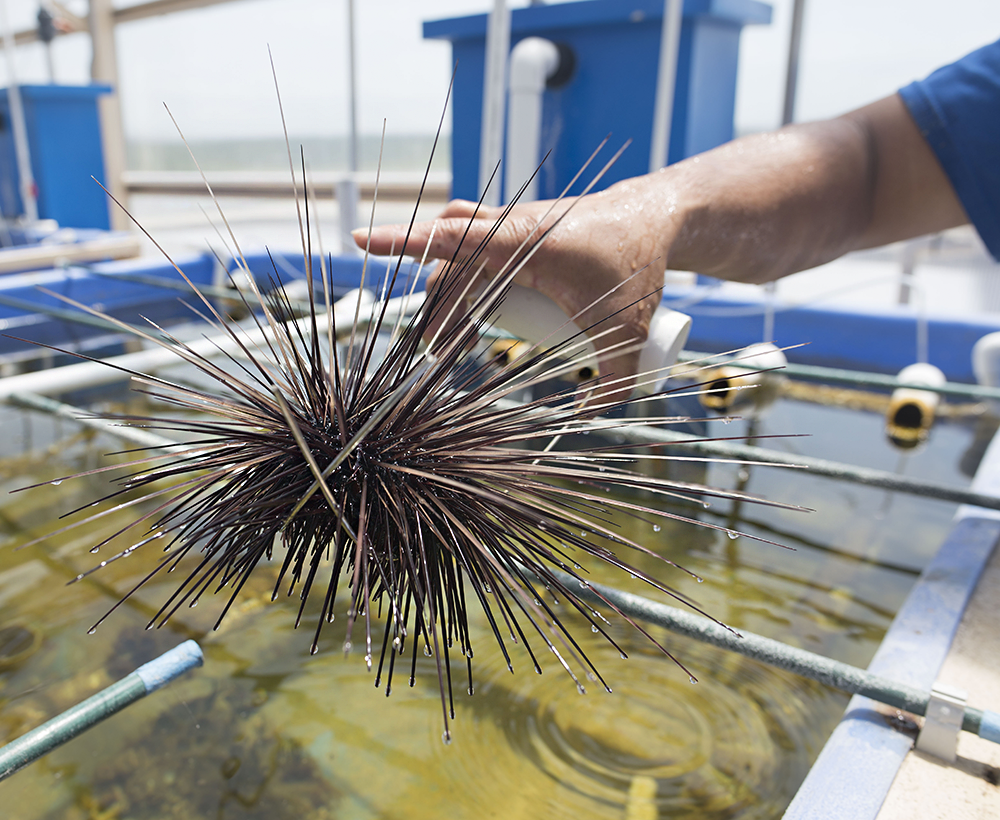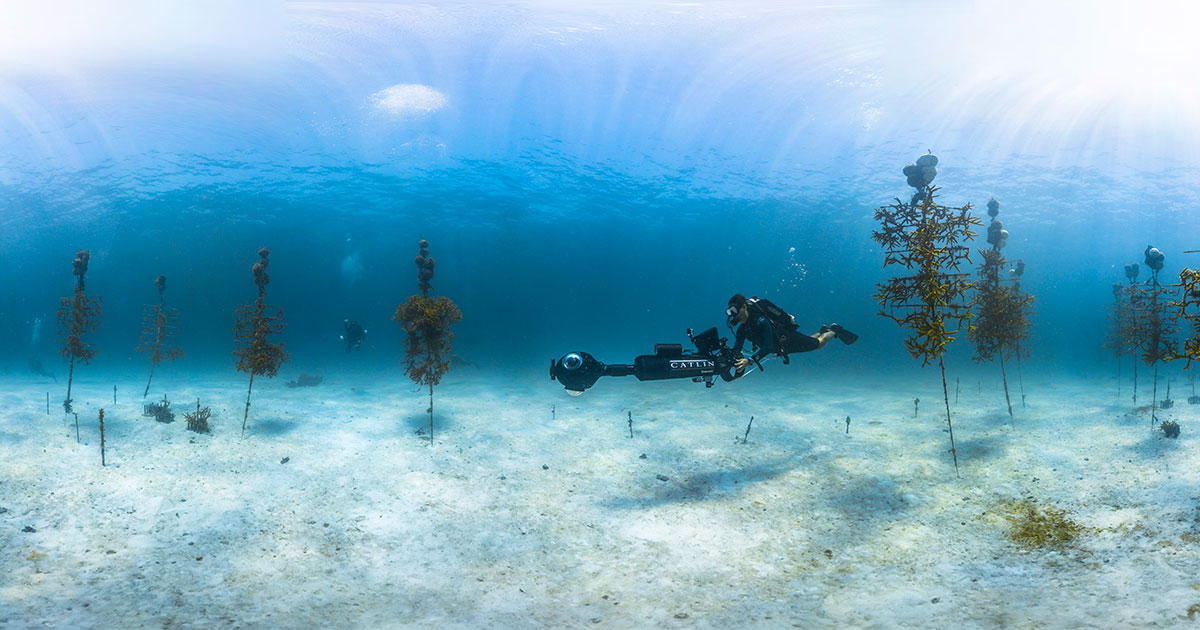When Andy Bruckner first started diving the Florida Keys reefs some forty years ago, what caught his attention were the thickets of beautiful Elkhorn and Staghorn corals, thriving amongst vast networks of other corals and marine life, collectively comprising a diverse and extensive reef ecosystem. Through decades of in-water experience, he saw firsthand the stepwise decline of Caribbean reef health and the corresponding loss of coral life. This memory of what once was spurred Dr. Bruckner, now as Research Coordinator for the Florida Keys National Marine Sanctuary, to work towards a Florida Keys reef system that follows a better trajectory, and he’s not the only one. We’re collectively moving towards this better future by joining forces with all those working to achieve this aim at great scale.
Mission: Iconic Reefs is one of the largest collaborative coral reef restoration efforts that the world has yet seen, made possible through years of research, relationships, and sheer grit that have laid the comprehensive foundations—both tangible and intangible—for the mission’s success. It is an unprecedented effort to pair the immediately feasible with the progressively possible so that we can have thriving, restored reefs. Led by the US National Oceanic and Atmospheric Administration (NOAA), the initiative is a multi-partner effort bringing together nonprofit coral restoration organizations; personnel from multiple NOAA Line Offices, the National Marine Sanctuary Foundation (the Foundation), multiple Florida State Agencies, and United Way of Collier and the Keys; representatives from international organizations, such as the Coral Restoration Consortium; researchers from various local and national Universities; and members of the local Keys community.

Mote Marine Laboratory on Summerland Key developed a micro-fragmentation and fusion method to speed the growth of crucial reef-building species. (Image credit: Mote Marine Laboratory and Aquarium)
Each of the above is coming together in order to meet the needs of the reef ecosystem; overall, there’s an understanding that impactful restoration of our coral reefs is only truly possible by working together through a collective ‘we’ approach.
To Restore the Reef, We Must Be Actionable Workers
Mission: Iconic Reefs aims to ultimately add over 500,000 mature corals of more than half of the native stony coral species found in Florida, at seven key reefs spread across the Florida Keys reef tract. The end goal is to have seven sustainably flourishing reefs acting as productive neighbors to their counterparts throughout the Florida Keys National Marine Sanctuary. Spanning two implementation phases and 20 years, Iconic Reefs was thoughtfully developed based on years of cumulative scientific research. Total outplant numbers were calculated with species-specific growth and mortality rates, overlaid with ground-truthed measures of restorable area at each chosen reef site. The result is a comprehensive plan that sets the stage for a hefty amount of work! Thankfully, Iconic Reef’s restoration partners who are actively outplanting corals at large scales—namely, the Coral Restoration Foundation™, Mote Marine Laboratory, and Reef Renewal USA—are true leaders in the coral restoration field, engaging in work that is both innovative in form and impressive in scale.

A member of the FKNMS Buoy team beneath the water tying a mooring buoy line within the Sanctuary. Buoys protect the reefs from anchor damage, while still enabling recreational use of the reefs. (Image credit: Matt McIntosh/NOAA)
For the mission, every good weather day is a fieldwork day. Complementing this dedicated in-water fieldwork is the connective tissue of management that works across all partners to streamline efforts, so that policies and governance match the ethos of what’s accomplished under the waves. It’s all-around tough work, but this extensive coordination and implementation network enhances the long-term success of the work.
To Support the Reef, We Must Be Innovative Researchers
Restoring a reef takes more than reviving the corals themselves, although that alone is no small feat. We’re pursuing the new and novel by aiming to bring entire reef ecosystems into a state of flourish, so we need to think beyond obvious needs, and into the nuanced details that provide a reef its true resilience and complexity. To that end, the Iconic Reefs plan includes the intentional distribution of herbivorous grazers—animals like Caribbean King Crab and the Long-Spined Sea Urchin, that consume enough algae to help shift a reef ecosystem away from an algal-dominated state and to a coral-dominated state. With research and development in hand, over 200,000 grazers are part of planned reintroduction for each Iconic Reefs’ phase.
To meet this demand, upscaled mariculture of both of these grazers is ongoing. For Caribbean King Crab, current work at both the College of the Florida Keys and Florida International University is enabling identification of the key factors necessary for large-scale propagation of these animals. And at the University of Florida, similar work is occurring for the historically-abundant Long-Spined Sea Urchin. All of these mariculture efforts point to the potential for expanding our perspective beyond restoration needs alone, and to possible integration into the Keys blue economy—in other words, could we make grazer production a marketable commodity? After all, the crab that consumes our reefs’ algae can be grown in the same facility as the crab that’s consumed by local residents! We’re exploring these options and more, as the research continues.

A Long-Spined Sea Urchin in the lab at the University of Florida. (Image credit: Joshua Patterson, University of Florida)
Additional work on rebuilding coral populations through genetic management is key to defining the restoration success. Development of an Iconic Reefs Genetic Diversity Plan is ongoing, based on results from Keys-wide genotyping of both wild and sexually-propagated corals. And while there’s intentional diversification of the species-specific genotypes present at an Iconic Reefs site, we’re also paying attention to the most resilient, robust individuals—those corals that seem to do well when others don’t; the question remains—can we seed our reefs with the corals best prepared to withstand future climatic conditions? This work—with partners like The Florida Aquarium, among others—is ongoing in order to say a confident yes.
To Serve the Reef, We Must Be Personable Stewards
Reef stewardship involves serving both the reefs and the people who depend on them, and we must tend to both to properly care for the socio-ecological system as a whole.
For the reef, site preparation, maintenance and monitoring are all critical activities of the restoration process. Site preparation enables a reef to receive outplants through the removal of nuisance species that may take up critical habitat space. Maintenance tends for the outplanted area over time, with additional effort spent directly caring for individual coral colonies. Monitoring looks at the outplanting progression to date and its effect or influence on the surrounding reef environment. To accomplish these activities at all seven sites, we must leverage the involvement of the dive community at large, facilitated through such public/private partnerships as that of NOAA, the Foundation and dive operators. One such partnered stewardship program—currently in development—aims to partner with locally-accredited Blue Star dive operators to engage in this work with both their staff and their clients. This engagement will help to make environmental stewards of both locals and tourists, directly showcasing the level of care and effort needed to uphold our reefs.

Caribbean King Crab. (Image credit: Jason Spadaro, College of the Florida Keys)
For Iconic Reefs to serve people, we focus on the next generation and on those most in need, noting that jobs from ocean recreation and tourism constitute nearly 60 percent of the local Keys economy. United Way of Collier and the Keys facilitates much of these people-focused stewardship needs, with plans to a) expand the pre-existing NOAA Ocean Guardian School program for Keys schools, b) create marine science-centered scholarships and internship opportunities and c) develop reef-based excursion programs that provide real connectivity between restoration and sustainable Keys livelihoods, for our paycheck-to-paycheck community members.
The human-reef relationship is a symbiotic one and therefore restoration work must inherently understand these dependencies and work hard to ensure their mutual health.
To Be the Best Version of Our Collective Selves, We Must Restore Our Reefs
We can be bold in this unprecedented endeavor, not because we inherently know the solutions to every challenge that will inevitably arise, but because we must be a shared community whose choices tell the story of renewal, redemption and restoration—whose actions speak to a turning point in our mentalities and in the tangible outcomes of our management decisions. We must work towards a future that is as hopeful as the past memories that Dr. Bruckner holds, and as innovative as our imagination and drive allows us. From mariculture to community engagement initiatives, the restoration of our reefs is truly more ingrained in our future wellbeing than ever before.
This feature appeared in Environment, Coastal & Offshore (ECO) Magazine's 2021 Autumn edition, to read more access the magazine here.





